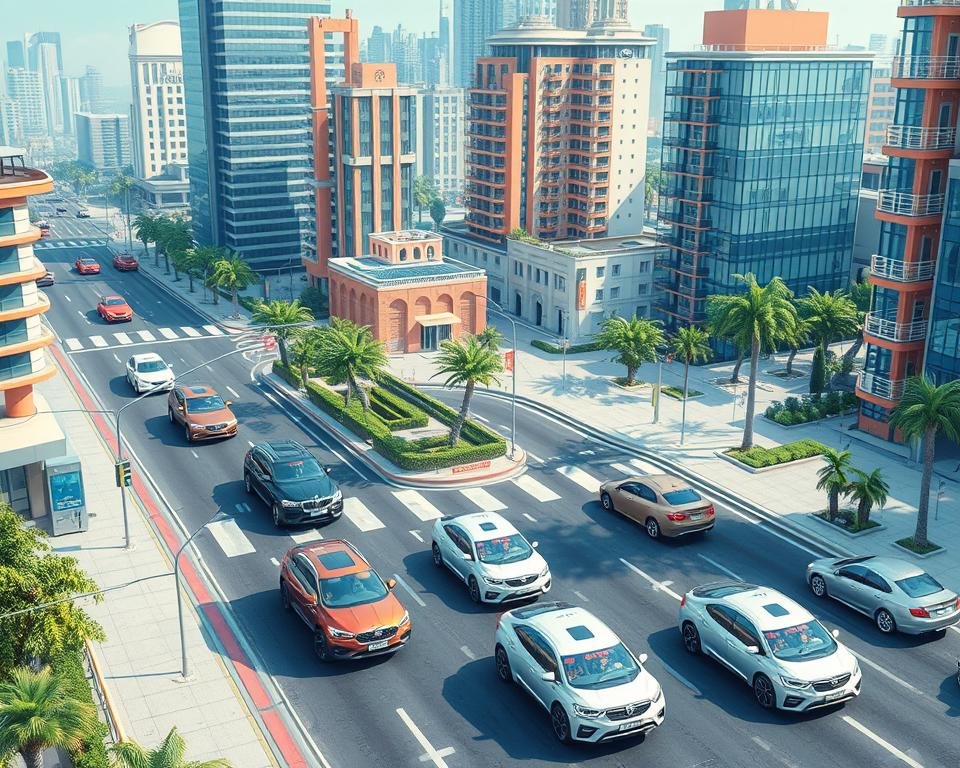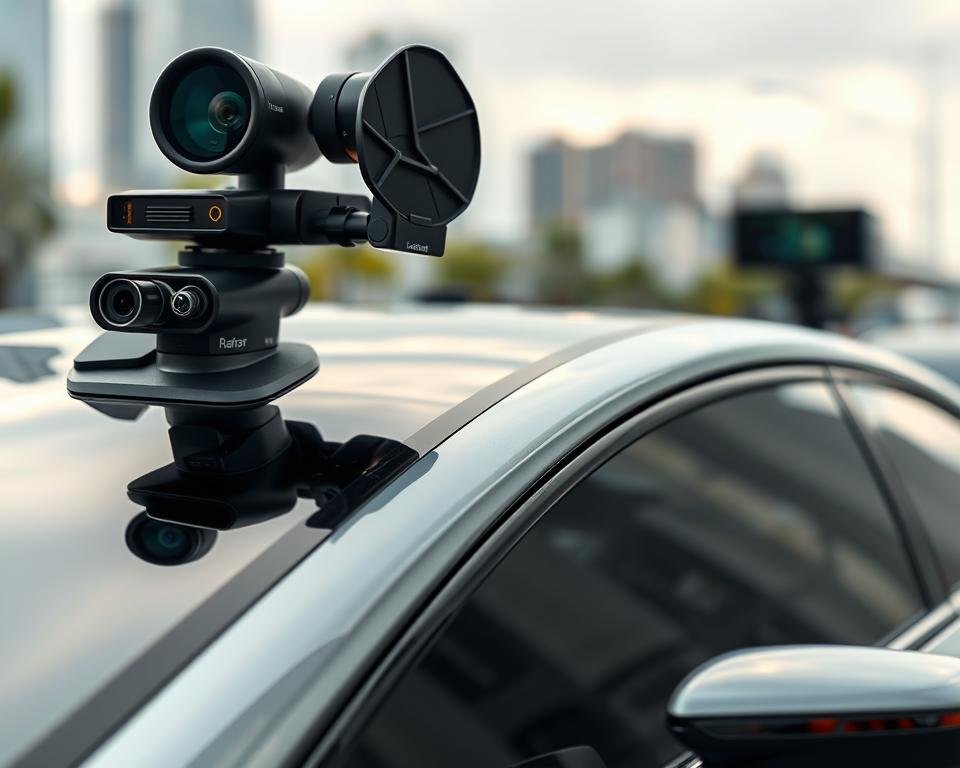A new technology is changing how we travel: Autonomous Vehicles. These cars use smart sensors and systems. They promise a safer and easier way to get around.
As these cars get better, how we use them will change too. We’ll see more connected cars and smart traffic systems. This will make traveling easier and safer for everyone.
Key Takeaways
- Autonomous vehicles are a transformative transportation technology that will reshape the way we move.
- These advanced vehicles are powered by advanced sensors, algorithms, and interconnected systems.
- Autonomous vehicles are driving the integration of connected and automated vehicles, intelligent transportation systems, and mobility as a service.
- The development of autonomous vehicles is accelerating, promising a safer, more efficient, and more convenient transportation experience.
- Autonomous vehicles represent a significant shift in the way we think about and interact with our modes of transportation.
Understanding Autonomous Vehicles
Autonomous vehicles, also known as self-driving cars or robotic cars, are changing how we travel. They have smart sensors and AI to drive on their own. This means they can move without a person inside.
What are Autonomous Vehicles?
Autonomous vehicles are cars that can drive by themselves. They use cameras, radar, and lidar to see and decide what to do. This lets them handle traffic and unexpected events.
Levels of Vehicle Automation
There are different levels of car automation. These range from simple help to full self-driving. Here are the levels:
- Level 1 (Driver Assistance): The car helps with things like staying in the lane or controlling speed.
- Level 2 (Partial Automation): The car can do many things at once, like steering and braking. But the driver must stay alert.
- Level 3 (Conditional Automation): The car can drive in certain situations, like on highways. But the driver must be ready to take over.
- Level 4 (High Automation): The car can drive in a specific area without a person. But it needs to follow rules.
- Level 5 (Full Automation): The car can drive anywhere, anytime, without a person.
As technology gets better, we’re moving towards Level 5. This would change how we travel forever.

Autonomous Vehicles Technologies
Autonomous vehicles (AVs) are changing how we travel. They use Advanced Driver Assistance Systems (ADAS) and sensors to move on their own.
Advanced Driver Assistance Systems (ADAS)
ADAS make cars safer and easier to use. They use cameras, radar, and lidar to watch around the car. This helps with stopping fast, staying in the lane, and keeping a safe distance.
ADAS helps cars get ready for driving on their own. This is a big step towards cars that can drive without us.
Sensors and Perception Systems
AVs need sensors to see and understand their world. They have cameras, radar, lidar, and ultrasonic sensors. These work together to know what’s around the car.
Then, special computers and AI make choices for the car. This lets it move and talk to other cars and people on the road.
| Sensor Type | Function |
|---|---|
| Cameras | Provide high-resolution visual information for object detection, classification, and tracking. |
| Radar | Detect and measure the distance, speed, and direction of nearby objects using radio waves. |
| Lidar | Employ laser technology to create detailed 3D maps of the surrounding environment. |
| Ultrasonic Sensors | Monitor close-range obstacles and aid in features like parking assistance. |
By using ADAS and sensors, AVs will change how we travel. They will make driving safer, more efficient, and easier for everyone.

Autonomous Vehicles: Shaping the Future of Mobility
The world is changing fast with autonomous vehicles. Your daily trips and life are about to change a lot. These cars can drive themselves, making travel easier and safer.
Autonomous cars will make driving less of a hassle. They will help reduce traffic jams and make roads safer. This means you’ll save time and travel safer.
Autonomous vehicles will also change how we get around. You’ll have easy access to rides, cars, and deliveries. This makes traveling easier and more green, helping our planet.
What are autonomous vehicles?
Autonomous vehicles are cars that can drive by themselves. They use special tech to move without a driver. This tech includes sensors, cameras, and AI to help them decide how to move.
What are the different levels of vehicle automation?
There are five levels of car automation. They range from no automation to full automation. Here’s what each level means:
- 0 Level: No Automation – The driver does all the work.
- 1 Level: Driver Assistance – The car helps with some tasks, but the driver must control it.
- 2 Level: Partial Automation – The car can steer and speed up, but the driver must stay alert.
- 3 Level: Conditional Automation – The car does most tasks, but the driver must be ready to help.
- 4 Level: High Automation – The car can drive in certain areas or on set routes without a driver.
- 5 Level: Full Automation – The car can drive anywhere without a driver.
What are the key technologies that enable autonomous vehicles?
Autonomous cars use many advanced technologies. These include:
- Advanced Driver Assistance Systems (ADAS): These systems help with safety and make driving easier. They include features like automatic emergency braking and lane-keeping assistance.
- Sensors and Perception Systems: Cars use sensors like cameras and radar to understand their surroundings.
- Artificial Intelligence and Machine Learning: These help the car make decisions and navigate safely.
- Connectivity and Networking: Cars can connect to the internet and other cars. This helps them share data and move better together.
How will autonomous vehicles shape the future of mobility?
Autonomous cars will change how we travel. They promise to make roads safer and more accessible. Here’s how:
- Improved Road Safety: They can avoid accidents caused by human mistakes, making roads safer.
- Enhanced Mobility and Accessibility: They offer rides to those who can’t drive, improving their lives.
- Reduced Traffic Congestion and Emissions: They can help traffic flow better, cutting down on congestion and pollution.
- New Mobility-as-a-Service (MaaS) Opportunities: They open up new ways to travel, like on-demand rides and self-driving public transport.

Pingback: Advanced Robotics: 6 Amazing Future Trends - Tech Passion
Pingback: Are Electric Cars Better for the Environment? - Tech Passion